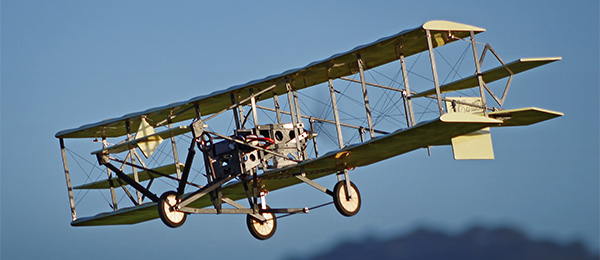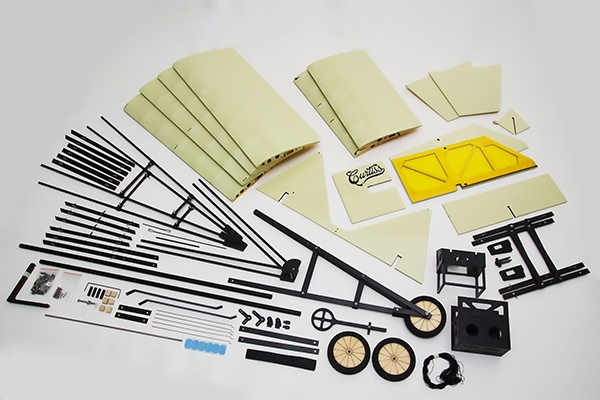Maxford USA Curtiss Pusher ARF

Written by Jon Barnes Experience the thrill of early aviation Abridged product review Photos by the author Read the full product review in the February 2016 issue of Model Aviation.
Specifications
Model type: 1/9-scale sport electric ARF Skill level: Intermediate Wingspan: 50 inches Wing area: 788 square inches Length: 48.5 inches Weight: 5.5 to 6 pounds Power system: NTM 35-42-1,000 Kv brushless outrunner with 50-amp speed controller; 11 x 7 APC E propeller Radio: Tactic TTX850 eight-channel 2.4 GHz SLT transmitter; Tactic TR624 six-channel 2.4 GHz SLT receiver Construction: Balsa, plywood, and composite Covering: Two colors of Mylar covering Street price: $229.99Test-model Details
Motor used: NTM 35-42 1,000 Kv brushless outrunner Battery: Turnigy Nano-tech 4S 3,300 mAh 65C LiPo Propeller: APC E 11 x 7 Radio system: Tactic TTX850 eight-channel 2.4 GHz SLT transmitter; Tactic TR624 six-channel 2.4 GHz SLT receiver; two Futaba S3156 servos; three Hextronics HXT-900 9-gram servos Ready-to-fly weight: 5 pounds, 8 ounces Flight duration: 5 minutesPluses
• A unique model that allows pilots to recreate the early days of aviation. • Factory-prepared slots and boxes allow all airframe components to key together nicely. • In-flight performance enhances the scale realism of the model. • The model can be completed and flown using economical electronic components.Minuses
• Difficult to source an appropriate pilot figure. • Model requires a substantial amount of ballast in the nose to achieve the recommended CG. • Exposed servo leads detract from overall scale realism.Product Review
What do the Rumpler Taube, the Blériot XI, and the Curtiss Model D all have in common? All three airplanes harken to the infancy of fixed-wing aviation. They each made their first flights shortly after the start of the 20th century (1909-1911). This, however, is not the only thing that united these three vintage aircraft. More relevant to the readers of this magazine is that all are available as RC models from Maxford USA. Although many mainstream model manufacturers focus on creating new versions of commonly modeled airplanes, Maxford USA has earned a reputation for offering a stimulating variety of ARF kits based on infrequently modeled and vintage airplanes. I was interested to see Maxford announce the release of its 1/9-scale 1911 Curtiss Model D and I eagerly agreed to review the kit. The prebuilt airframe components are covered in a two-tone Mylar covering scheme. The upper side of the airplane is covered in a cream color, while the bottom side has a translucent yellow covering that shows off the airframe’s wooden skeleton and attempts to replicate the look of the full-scale airplane’s undercambered wings. Maxford offers an appropriate size electric power system, along with several optional components that can enhance the aircraft’s scalelike appearance.
Many of the kit’s components come partially assembled. This helps to speed the build along.
Flying
I wanted to verify that the selected power system would possess ample power to propel the model up and into the sky. An Eagle Tree Systems eLogger revealed that the NTM outrunner motor and 11 x 7 propeller were good for slightly more than 800 watts static. I was pleased to discover that although the nose gear is fixed, the small rudder exerts enough authority to induce gradual turns. Quick bursts of throttle, with the ensuing airflow across the rudder, allow a pilot to make modest steering corrections. I slowly eased the throttle forward and let the Model D accelerate down the runway. It did not take much runway or elevator input to coax the biplane into the air. The sight of the Curtiss breaking ground and climbing out was exhilarating! With a half dozen clicks of down-elevator applied, the model felt trimmed out. I noticed a slight tendency for the nose to slowly rise while flying around the pattern. With the flight taking place shortly after dawn and nothing more than a faint whisper of wind present, this tendency could not be attributed to flying upwind or downwind. I theorize that the foreplane, a control surface typically lacking in the models that we fly, could be responsible for generating extra lift, but the effect was subtle and easily remedied with a slight bump of down-elevator. With the throttle slightly below 50%, I made a wide, sweeping turn through base and onto final approach. With the throttle pulled back to roughly a third, the Curtiss Pusher adopted a shallow rate of descent. Once across the numbers, I slowly rolled the throttle back. The model responded by reconnecting with, and sticking to, the runway surface with no sign of a bounce.










1 comments
Maxford Curtiss model D
Add new comment